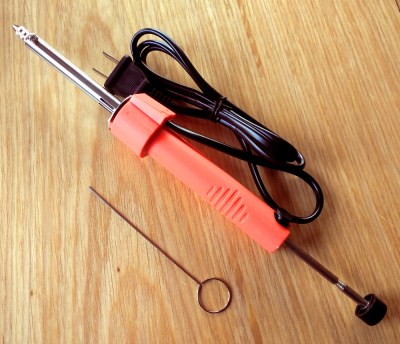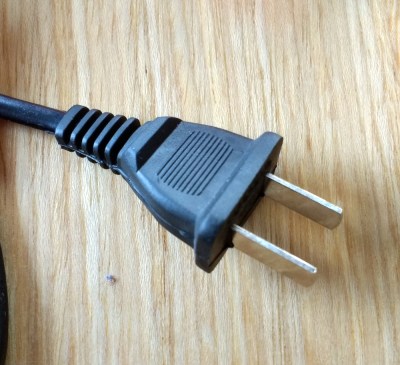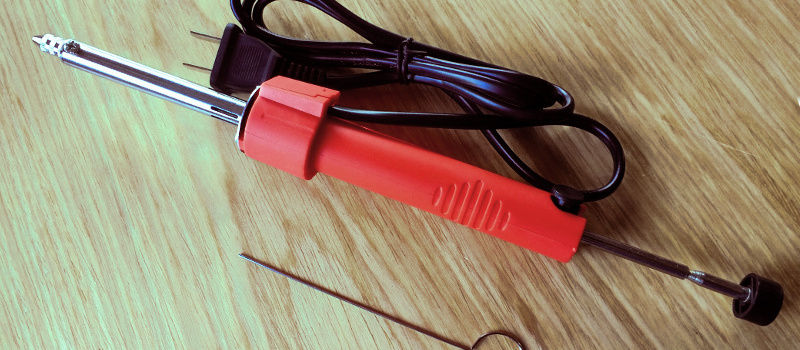This unholy lovechild of a cheap solder sucker and an even cheaper soldering iron is the HBTool HB-019 desoldering iron. It came to me for the princely sum of five pounds ($7). So for somewhere between the cost of a pint of foaming ale and the pub’s pie and mash I’d eat alongside it, what had I got?
Regular Hackaday readers will be familiar with my penchant for ordering cheap tools and other electronic gizmos from the usual suppliers of Far Eastern tech, and subjecting them to review for your entertainment and edification. Sometimes the products are so laughably bad as to be next-to-worthless, other times they show enough promise to be of use, and just occasionally they turn out to be a genuine diamond in the rough, a real discovery. This is no precious stone, but it still makes for an entertaining review.
The Mystery is in the Power Cord

Taking the unit out of its blister pack, I had what looked like a slightly chunky take on a cheap iron, but with the plunger of a solder sucker protruding from the end of its handle where you would normally expect the power cord to be. The cord in turn came from the side of the handle near its business end. At the tip of the element, instead of the normal soldering bit there was a wide nozzle with a roughly 3mm (1/8″) hole in its end.
The cord is 3A twin-core, with no earth conductor. There is no regulatory information on the iron itself or on the box that I could find after a Chinese translating session with Google Translate, so it was in question whether or not the unit was double-insulated. The brown and blue live and neutral wires were just visible through the narrow gap between the element base plate and the handle, so I suspect that the unit wouldn’t qualify as such. Undoing the three screws revealed that they immediately passed into heatproof insulated shrouding to connect to the element.

Unusually the desoldering iron came with an American-style NEMA 2-pin plug stamped “240V 6A”. Since this is normally a 120V connector I checked my order, and yes I’d bought the 240V version. Erring on the side of caution I measured its resistance, which at 2K ohms equates to just below the rated 30W at 240V. Still reserving some caution, I plugged it in through a travel adaptor and a plug-in power meter, and found it to be drawing 29W when at full temperature. I have no idea where in the world they use two-pin NEMA plugs with 240V, but I’m not sure I want to live there. Off came the NEMA, on went a BS1363 with the appropriate fuse.
Desoldering Test
Plugging the iron in for the first time to try a bit of desoldering, it generated a lot of smoke. It is normal for a new iron to smoke a bit due to oil from its manufacture, but this one generated significant smoke. I’m guessing this is because the plunger mechanism carries some grease, and that this had found its way into the hot end.
In use, a desoldering iron such as this one is an effective tool, and more so than the standalone solder suckers we all know and love. It required a bit of tinning before first use, and it isn’t very powerful so sometimes it takes a while to melt large joints. But the combination of direct heat and a tool that is itself at solder melting temperature meant that surplus solder was removed extremely effectively, allowing components to be quickly removed with minimal damage to the test scrap ATX power supply PCB.
Like Archery, But With a Soldering Tool

You might think that would be it, a review of a tool that was found to do exactly what it should. Sadly not, because it was during the testing phase that the solder sucker revealed an unexpected property: the ability to shoot its plunger a few feet at will.
Retrieving all the parts after the unexpected self-dismantling on the tool revealed the culprit: the piston seemed only to be an interference fit on its end. Repeated mechanical shock from operating the plunger had caused it to work loose, and the spring was strong enough to catapult it across my bench. It was easy enough to reassemble, but using it now becomes a lottery of waiting for the next plunger ejection.
So, what can we take away from this review? First of all, desoldering pumps with built-in heat are excellent tools that make the task so much easier than when performed with a traditional solder sucker. Buy one now. But don’t buy this one, it’s no diamond in the rough and I’d have done better to spend my fiver on that pub meal.
It probably won’t subject you to electric shock but probably isn’t really good enough, and its build quality is poor enough that its explosive deconstruction is suitably comedic. If I wanted to fix it I’d cut a thread on the end of the plunger and put a nut on it, but then I’d also have to look at adding a mains flex with an earth wire. Whether I find the motivation to do this will probably depend on the future urgency of my need for efficient desoldering, so it will inevitably be done in a hurry alongside something on my bench in need of urgent repair.
The HBTool HB-019 desoldering iron then. Not a hit, but a comedy of ballistic plunger parts, inappropriate connectors, and mains safety that could perhaps use a little bit of attention. I bought one, so you don’t have to.















I see it is “plunger style”.
Be sure to wear safety glasses when using it, so you don’t accidentally get punched in the eye.
Any chance you purchased this on April 1?
Thanks for the warning though, we may see it selling on amazon soon with lots of fake 5 star reviews
Excellent review. Just looking at the photos, the location of the power cord looks like it would be very awkward to use as it would always be getting in the way. That bow and arrow feature might come in handy though, ha ha.
of a different design, this 1 is pretty good (30W).. https://www.velleman.eu/images/products/1/vtdesol3.jpg
sometimes i mount it in a vice.
I think you mean a vise, a vice is like, a bad habit :-P
It depends where you live ;-)
http://grammarist.com/spelling/vice-vise/
Vise-versa,
vis-a-vis,
C’est la vie!
B^)
And a vise is also the place where you keep your Cockford Ollie :))
is that an avg reference :)
I bought that one… used it twice, delaminated a few tracks because it lacks temperature regulation, and bought a ZD-985…
Not bad, Amazon has the US version for only ten bucks, I may need to get one of these:
https://www.amazon.com/Velleman-VTDESOL3U-Vacuum-Desoldering-Heater/dp/B00B88FRME
Amazon.de users gives it 3 out of 5 stars
https://www.amazon.de/Velleman-Entl%C3%B6tpumpe-Entl%C3%B6tkolben-230V-VTDESOL3/dp/B005HCQRQ2/
I didn’t find the power cord location to be a problem, strangely enough. As I said, it was quite a good tool to use, and I’d have given it a much better review had it been better screwed together.
FYI, that plug is a standard Chinese 250V / 6amp. You can tell because there are not holes in the ends of the plugs
Also used in Japan for 100V
Curious, all the Chinese plugs I’ve seen have had pins slanted inwards like the Aussie ones. You lives and learns.
They are used in the Philippines too.
“I have no idea where in the world they use two-pin NEMA plugs with 240V…”
I’m currently in China and have a US Apple power brick plugged into a wall socket that’s running at 220VAC. It seems that, in China and elsewhere, it is common to have these NEMA plugs wired up to whatever the local voltage is. (This is probably why switching power bricks have such a wide input range (e.g. 100-240VAC), even when they don’t have detachable cables.)
https://en.m.wikipedia.org/wiki/AC_power_plugs_and_sockets
(Go to the “China CPSS-CCC (Type 1)” section of “Types in Present Use”)
That and it’s cheaper to just make a universal power supply that will accept a range of mains frequencies and just change the plug for various markets versus having to have a separate power supply board for each market, plus do away with the 120/240V switch that can cause problems when it’s in the wrong position
[quote]I have no idea where in the world they use two-pin NEMA plugs with 240V, but I’m not sure I want to live there.[/quote]
Shenzhen! The typical SZ outlet is the amalgamation of every outlet style, and runs off 240V – quite scary when you first encounter them, but you have to remember that they manufacture the worlds products so it makes sense that they want to be able to plug anything in as who knows where a specific item was manufactured to be used.
I’m surprised you haven’t come across this Chinese mains plug before if you’ve got so many thing direct from there.
I tend to buy the version with the European plug if it’s available, seeing as I’m in Europe. I didn’t know this was a standard in China too.
I have something similiar, it calls itself ZD-211, claims 40W and comes with a Schuko plug, meaning the tip is grounded (I checked that before using).
It works OK once you learn how to use it, so the principle is sound. The only problem is that the tip doesn’t last very long, it gets corroded by the solder.
Solder tips generally degrade from a combination of heat, air and lack of solder. Keep the tip tinned for best results. The quality of the materials used in the tip obviously make a difference, too. The rosin (or other) core inside the solder also helps slow deterioration. Do not use solid (no core) solder or any solder not specifically intended for electronics use (as I’m sure you well know, but noobs might not). Thanks for your comments.
Fill the chamber with PLA, press the plunger with your thumb and see if you can use it as an incendiary 3D pen.
I really hope you mean improvised 3D pen.
Personally I wouldn’t want to have an INCENDIARY 3D pen. I like my stuff flame free.
This probably wouldn’t work as a 3D pen, there’s basically no temperature regulation so either gets too hot or too cold depending on flow rate.
As you pointed out no temperature regulation, so despite the intent, it would likely become a incendiary 3d pen…
I chose the word “incendiary” with great care.
I have taken a solemn oath to never again own, possess, or use a soldering tool of any kind that is not earth grounded. A few years ago I destroyed 10 hrs of work with an old soldering iron that I thought would be good enough for a quick fix. The iron must have had a significant voltage on it because NOTHING on that board worked afterward.
If a mains powered soldering iron is leaking that much voltage, you have much bigger problems.
Earth grounded soldering irons are a double edged sword IMHO. Yes, you want some grounding to prevent ESD damage.. but if your board isn’t at ground potential already, you just made the problem worse.
I’ve destroyed more projects by having the earth ground, than by not having it as I have the bad habit of working on simple stuff while it’s live. If you do this with an earth grounded iron, you are most certainly going to fry things. Not the mains side of projects of course, but a great many low voltage power supplies also tie to earth ground on one of the low voltage legs.
So now my earth ground for my ‘working’ iron goes through a 1M resistor and I don’t think twice about it.
So you are soldering on boards that are not only powered, but powered by line voltage? I don’t think the soldering iron is the problem.
Things like changing a fan connector or putting new ends on a bldc motor driver. Yes, I will do that powered. I did say it was a bad habit didn’t I. :)
I am forced to do some soldering on powered items, but they are all battery powered.
I was horrified to receive a China sourced device recently which had the usual kettle lead power cable — but the plug, whilst UK format, had no fuse! The giveaway that made me look closer was the super skinny light weight design. The cable itself was woefully underrated. Death trap in waiting, keep your eyes peeled.
If replacement tips are available, this might be a good candidate for retro-fitting with a proper-but-cheap vacuum pump and a foot pedal to activate it. Some fine steel wool in place of the plunger and O-ring would provide basic filtering to keep solder out of the pump. Maybe add a light dimmer to provide some semblance of temperature control.
You may claim to be a cat,jenningsthecat, but I get the feeling you’re actually an inventor. How about a small water bath at the bottom of a tube that catches all the solder, while an ascending tube from there goes to the pump? Most dimmer switches seem to announce “for incandescent use only” but where’s the fun in that? I’d bet for a 30-watt iron it would work just fine. Besides, 30 watts is not much for desoldering. And running a pump constantly would cool the tip too much. I see a couple of repurposed foot pedals in your future . . .
I don’t think molten solder is going to travel far enough to make it to a container full of water, good as they idea may seem.
Typically, there is a wide area right out of the heater/nozzle filled with something not flammable to allow the solder to be caught but not clog the air flow until a lot accumulates.
I had such a “tool”.
Unfortunately I couldn’t test it’s desoldering capability as after about one second the poorly built heating element emitted a short burst of smoke and died.
Of course mine also wasn’t grounded as the one in the review.